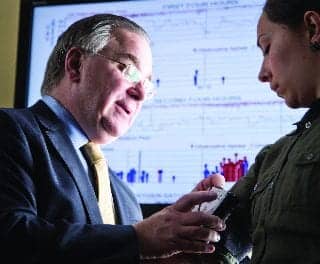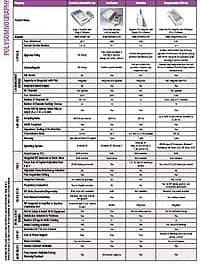As payors become more stringent about who can get an in-lab polysomnogram, sleep technologists have found that the patients who come in for a test often have multiple comorbidities. Planning for each patient in advance is one strategy that can make a big difference.
By Lisa Spear
1. Screen the Patients Ahead of Time
Patients can be screened over the phone before they come to the sleep lab to discern what, if any, special accommodations they will need. The staff member who schedules appointments can be trained to ask appropriate questions to see if the patient has any comorbidities or if they require any accommodations, says Joel Porquez, BS, RPSGT, RST, CCSH, who serves on the American Association of Sleep Technologists’ executive board.
An experienced polysomnographer, Porquez says that asking the right questions before a patient comes into the lab can help avoid problems. Questions may include: Have you had an in-lab sleep test before? Do you need an aide?
“Sometimes the technologist is unaware that the patient needs a lot of help, may even need help to go to the bathroom or to get in and out of bed,” says Porquez, who is also the founder and principal owner of Sleepkidzzz, a pediatric sleep training consulting company.
If a patient needs a lot of care, some labs may provide an aide for them or make sure a caregiver or family member accompanies the patient to the sleep lab.
2. Policies, Protocols, and Acuity Systems
Sleep labs benefit from thorough policies and procedures that give instructions for the comorbidities that technologists may encounter. Part of this may involve developing a patient acuity ranking system, a reference guide to determine the severity of a patient’s condition and how the on-duty technologist should respond to each scenario. For instance, a ranking of 1 would indicate that a patient has no special needs, whereas a 4 would indicate a patient who requires an advanced level of care.
Why is an acuity system important? Porquez explains that it will help with determining staff requirements. One tech may be able to handle two patients ranking low on the scale, but it might be too difficult for them to oversee two patients who have severe underlying health conditions, says Porquez, who is also a technical support specialist for medical device company Nox Medical.
3. Know Your Patient’s History
A comprehensive patient history can help technologists and sleep lab managers avoid any headaches. If staff members obtain the patient’s chart ahead of time, they should study it before the patient arrives. “We are seeing more patients with comorbid disorders coming through sleep disorder centers and my main advice to everyone is pre-visit planning,” says Barbara Ludwig-Cull, RPSGT, RST, chairperson of Stony Brook University’s polysomnographic technology program.
“In our lab, pre-visit planning means that every patient who is going to come in for a sleep study has their chart opened and reviewed prior to their arrival,” says Cull.
Ask patients to bring essential medications, including inhalers and glucose meters, especially ones that might need to be taken or used at bedtime, advises Teofilo Lee-Chiong, MD, chief medical liaison at Philips Sleep and Respiratory Care.
If it becomes difficult to get the patient’s chart, lab managers can require the requesting physicians to use an order form with a checklist of the most common comorbidities, says Henry Johns, RPSGT, CRT, CPFT, program manager for clinical specialty labs of the Veterans Administration’s Eastern Kansas Health Care System.
Patients can also be provided with an intake questionnaire to screen them for conditions or special needs. The questionnaire could be filled out by the patient at home or in the waiting room at the lab. This document could screen for conditions that the requesting physicians may not have included, including mental illness, a comorbidity commonly seen in people with sleep disorders.
4. Durable Equipment for Bariatric Patients
One of the most common comorbidities a sleep lab will encounter is obesity. If a sleep lab manager knows that a patient is coming in with a high body mass index, technologists should be prepared for those patients who might have mobility issues.
Managers may look to invest in bariatric mattresses that can withstand several hundred pounds. Sizewise, a company that manufactures bariatric furniture for medical facilities, markets sleep lab mattresses that have a 1,000-pound weight capacity.
Accessory equipment, including bedside lifts, may also be helpful in assisting the patients in and out of the bed. For example, Sizewise manufactures a lift that is low to the ground and rests below the base of the bedframe. This enables the techs to easily move the patient from a chair to a bed, says Erica Thibault, MS, RN, CNS, APN, CWON, clinical manager at Sizewise.
“If a patient is able to walk and turn themselves in bed, that is great, but what if they are not?” Thibault says.
Mattress suppliers will be able to tell you how much weight their mattresses are rated for, as well as the warranty period. Additionally, make sure that technologists are aware of the weight capacity of each sleep lab mattress. When scheduling obese patients, ensure that your bariatric bed will not already be in use by another patient, says Porquez.
Obesity in some patients can lead to their inability to breathe when laying flat. Often, these patients will sleep with multiple pillows or will prefer an adjustable bedframe to elevate their upper body during sleep, Thibault explains.
Sleep labs may also want to invest in walkers, wheelchairs, and other equipment that will assist patients with mobility issues.
5. The Power of Observation
Sleep technologists are in a prime position to take note of details that a physician might not have the opportunity to notice. When sleep lab staff note abnormalities or irregularities in the patients’ vitals, EEG data, or even anatomy, they should share their observations with the treating physician.
For example, insights from the in-lab test could assist in making diagnoses of conditions like temporomandibular joint disorders, restless legs syndrome, or even dementia, says Jeffrey Durmer, MD, PhD, a neurologist and sleep specialist who works as the chief medical officer for Nox Medical.
Technologists can learn how to better understand a patient’s pathophysiology by examining a patient’s mouth, tongue, jaw, and upper airway. There, they might find hints and indications as to why a patient may be experiencing disrupted sleep. “I find that the sleep laboratory is a great place to collaborate across the divide [between dental sleep medicine and sleep medicine],” Durmer says.
6. Give Them Comfort
Patients, especially those with comorbidities, usually don’t enjoy having to sleep overnight in a lab away from the comforts of home. Sleep lab managers can take many steps to make sure these patients are as comfortable as they can be.
Before a patient comes into the lab, they can be encouraged to bring with them any items that they are accustomed to having at home before bed. Children might have a favorite stuffed animal that they will want to bring along. If a patient has diabetes, it may be important for them to bring a snack to balance their blood sugar, says Johns, a VA sleep lab manager.
When a bariatric patient comes to the hospital, does the sleep lab have the right sized gown? Extra preparation in making sure that all the lab equipment can fit larger patients might save some patients from feeling embarrassed. “It’s not fair to the patient to walk into the room and say, ‘Oh, this isn’t going to work, I need to go get something else because you’re so big,’” says Thibault. “Is the furniture in the room going to meet the needs of your 800-pound patient or their family members?”
Another way to make patients comfortable is to keep them informed and educated about the sleep lab and what they will experience there. Patients who come in on supplemental oxygen may have to be taken off the oxygen for the technologist to collect baseline data. In this instance, staff members should explain why this is important. “The ability to talk to a patient, to reassure a patient, this is something that is not taught,” says Johns. “Sleep techs have to be able to talk to people, they have to be able to relate to people.”
Lisa Spear is associate editor of Sleep Review.




